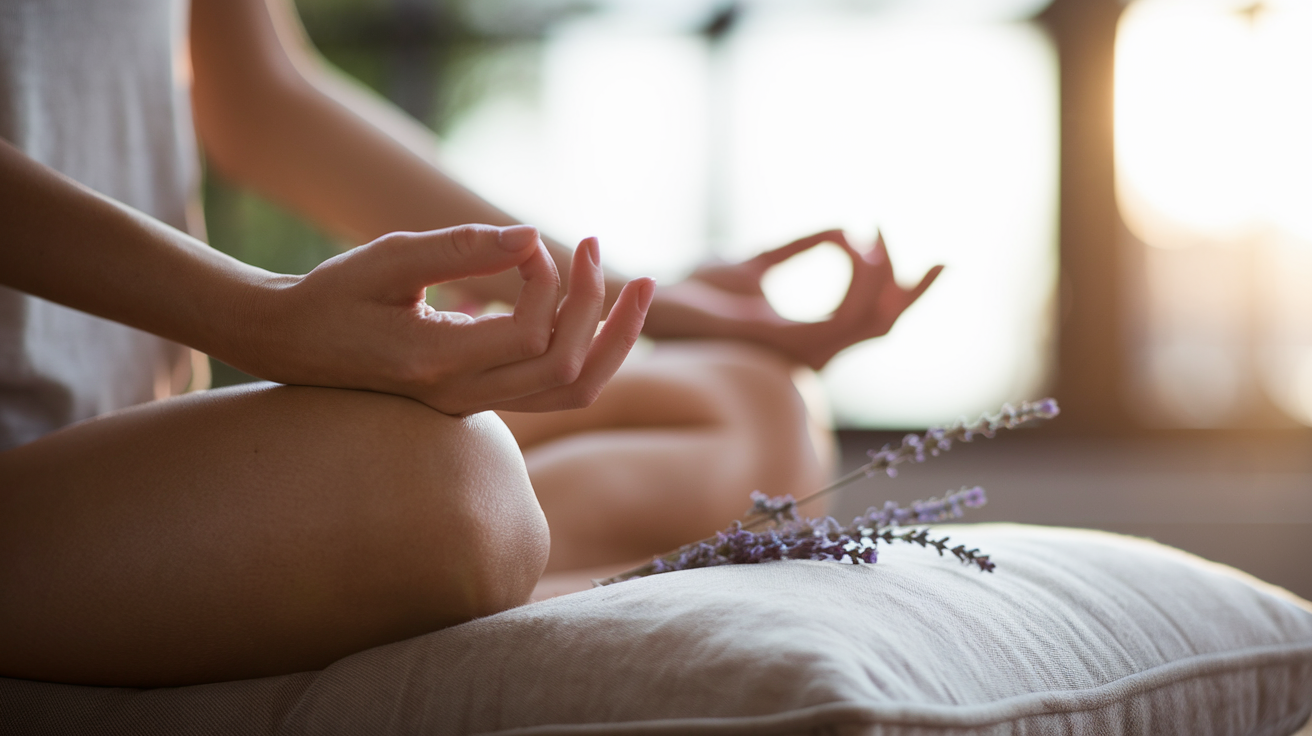
Why Mindfulness is the Shortcut to Knowing Yourself Deeply
Have you ever caught yourself halfway through your morning routine and realized you don’t remember a single thing you just did? Or found yourself reacting to a situation and wondered, “Where did that come from?” Most of us spend our days running on autopilot, moving through life without truly experiencing it—or understanding ourselves within it.
Here’s what might surprise you: the ancient practice of mindfulness isn’t just about stress reduction or meditation cushions. It’s actually the fastest, most direct path to genuine self-knowledge that humans have discovered. While therapy can take years and journaling requires consistent discipline, mindfulness offers immediate access to the workings of your own mind and heart.
In a world obsessed with quick fixes, mindfulness delivers something even better—a genuine shortcut to the deep self-awareness that transforms everything else in your life.
What Mindfulness Actually Is (Beyond the Buzzword)
Mindfulness has become such a popular term that its true meaning often gets lost in wellness marketing and meditation apps. At its core, mindfulness is the practice of paying attention to your present-moment experience with curiosity and acceptance, rather than judgment or the need to change anything.
Dr. Jon Kabat-Zinn, who brought mindfulness into mainstream medicine, defines it as “paying attention in a particular way: on purpose, in the present moment, and non-judgmentally.” This isn’t about emptying your mind or achieving some blissful state—it’s about becoming intimate with reality as it actually is, including the reality of your own inner landscape.
Research from Harvard neuroscientist Dr. Sara Lazar shows that just eight weeks of mindfulness practice literally changes your brain structure, increasing gray matter in areas associated with self-awareness, emotional regulation, and introspection. But you don’t need eight weeks to start experiencing insights—mindfulness begins working immediately because it’s simply a different way of relating to what’s already happening.
Think of mindfulness as becoming the loving, curious observer of your own life rather than being completely identified with every thought, emotion, or sensation that arises.
The Different Dimensions of Self-Knowledge Through Mindfulness
Emotional Awareness: Mindfulness teaches you to recognize emotions as they arise, before they trigger automatic reactions. Instead of being angry, you notice “anger is present.” This slight shift creates space for choice and deeper understanding of your emotional patterns.
Thought Observation: You begin to see that you are not your thoughts—you’re the awareness that notices thoughts. This recognition is profoundly liberating because it means you don’t have to believe or act on every mental story that passes through your consciousness.
Body Wisdom: Your body holds enormous intelligence about your needs, boundaries, and authentic responses to situations. Mindfulness helps you tune into these physical signals before your mind creates stories about them.
Values Clarification: When you’re present with your actual experience rather than lost in mental commentary, what truly matters to you becomes clearer. You start distinguishing between what you think you should want and what genuinely resonates with your authentic self.
Pattern Recognition: Mindfulness reveals the repetitive cycles of thoughts, emotions, and behaviors that usually operate below your conscious awareness. Once you can see these patterns clearly, you gain the power to change them.
Interpersonal Insight: Present-moment awareness extends to your relationships, helping you notice how you show up with others, what triggers your defenses, and when you’re truly connecting versus just going through social motions.
Why Mindfulness Works Faster Than Other Self-Discovery Methods
Traditional approaches to self-knowledge—therapy, journaling, personality tests—are valuable but often indirect. They rely on memory, interpretation, and analysis after the fact. Mindfulness gives you direct, real-time access to your inner experience as it’s actually happening.
Immediate Access: You don’t need to wait for insights to emerge over time. The moment you become mindfully aware, you’re already learning about yourself. Every experience becomes data about how you operate.
No Storytelling Required: Often, our attempts at self-understanding get tangled up in narratives about why we are the way we are. Mindfulness bypasses the story and goes straight to the raw experience, which is often more revealing than our explanations.
Built-in Laboratory: Every moment of your life becomes an opportunity for self-discovery when you’re paying attention mindfully. You don’t need special circumstances or scheduled sessions—your ordinary experience is the laboratory.
Reduces Mental Interference: Our thinking minds often get in the way of genuine self-knowledge by creating elaborate theories about ourselves. Mindfulness helps you experience yourself directly rather than through the filter of mental concepts.
Integrates Multiple Intelligence Centers: While purely mental approaches only engage your thinking mind, mindfulness includes emotional intelligence, somatic awareness, and intuitive knowing simultaneously.
Common Misconceptions That Keep People from Deeper Practice
“I’m Too Busy for Mindfulness”: Many people think mindfulness requires sitting in meditation for hours. In reality, you can practice mindful awareness while washing dishes, walking to work, or having conversations. It’s about quality of attention, not quantity of time.
“My Mind is Too Busy”: Having a busy mind is exactly why you need mindfulness, not a reason to avoid it. You’re not trying to stop thoughts—you’re learning to observe them without being controlled by them.
“It’s Just Relaxation”: While mindfulness can be relaxing, that’s not its primary purpose. Sometimes mindful awareness reveals uncomfortable truths or difficult emotions. The goal is clear seeing, not feeling good.
“I Need to Be Spiritual”: Mindfulness is a practical skill, not a religious practice. You don’t need to adopt any beliefs or lifestyle changes—just the willingness to pay attention to your actual experience.
“It Takes Years to Work”: While deepening mindfulness is a lifelong journey, insights begin immediately. The first time you notice a thought without believing it, or feel an emotion without being overwhelmed by it, you’ve already experienced the power of mindful awareness.
“I Should Feel Peaceful”: Peace might arise sometimes, but so might anxiety, sadness, or frustration. Mindfulness is about being present with whatever is actually happening, not manufacturing particular states.
Scientific Evidence for Mindfulness and Self-Awareness
The research supporting mindfulness as a path to self-knowledge is extensive and compelling. Studies consistently show that mindfulness practice enhances multiple dimensions of self-awareness.
Neuroplasticity Research: Brain imaging studies reveal that mindfulness practice increases activity in the prefrontal cortex, the area responsible for self-awareness and emotional regulation. At the same time, it decreases reactivity in the amygdala, the brain’s alarm system.
Emotional Intelligence Studies: Research published in the Journal of Clinical Psychology found that people who practiced mindfulness for just four weeks showed significant improvements in emotional awareness and regulation compared to control groups.
Interpersonal Awareness: Studies indicate that mindfulness practice enhances empathy and social cognition—you become more aware of both your own responses and others’ emotional states during interactions.
Decision-Making Research: Mindful individuals show improved decision-making capabilities because they can access more information about their authentic preferences rather than being driven purely by reactive patterns or social conditioning.
Stress Response Studies: While not directly about self-knowledge, research shows that mindfulness changes how you relate to stressful experiences, giving you clearer information about what genuinely threatens your wellbeing versus what just triggers old patterns.
Practical Mindfulness Techniques for Deep Self-Discovery
The RAIN Technique for Emotional Awareness
When difficult emotions arise, use RAIN: Recognize what you’re experiencing, Allow it to be present without trying to fix it, Investigate how it feels in your body and what thoughts accompany it, and Natural Awareness—simply rest in the awareness that can hold all experiences.
This technique transforms emotional challenges into opportunities for self-understanding rather than problems to be solved.
Body Scanning for Somatic Intelligence
Spend five minutes daily systematically noticing sensations throughout your body. Start at the top of your head and slowly move your attention down to your toes. This practice develops your ability to read the body’s wisdom about your needs, boundaries, and authentic responses.
Your body often knows what’s right for you before your mind figures it out.
Mindful Relationship Practice
During conversations, periodically check in with your internal experience. What are you feeling? What do you want? Are you listening or planning your response? Are you being authentic or performing a role?
This practice reveals your relationship patterns and helps you show up more genuinely with others.
The Thought Labeling Technique
When you notice thoughts arising, simply label them: “planning,” “worrying,” “judging,” “remembering.” This creates space between you and your thoughts, helping you recognize which mental patterns are most active and when.
You begin to see that thoughts are mental events, not necessarily truths about reality.
Values-Based Decision Making
Before making decisions, pause and tune into your body’s response to different options. Which choice creates expansion or ease? Which creates contraction or tension? Your embodied wisdom often knows what aligns with your values before your analytical mind can figure it out.
Present-Moment Choice Points
Throughout your day, pause and ask: “What does this moment require of me?” This question helps you respond authentically to situations rather than reacting from old patterns or social conditioning.
Integrating Mindfulness into Daily Life for Maximum Self-Discovery
Morning Intention Setting: Begin each day with two minutes of mindful awareness. Notice how you’re feeling, what your energy is like, and set an intention for how you want to show up during the day.
Mindful Transitions: Use transitions between activities as opportunities for brief mindfulness. Take three conscious breaths when you sit down at your computer, before you answer the phone, or when you get in your car.
Evening Reflection: End your day with mindful review. What did you learn about yourself? When did you feel most authentic? When did you notice old patterns arising? This isn’t about judgment—it’s about gathering data.
Mindful Communication: Practice listening without planning your response. Notice when you’re truly present with others versus when you’re distracted or performing. Pay attention to how different people and conversations affect your energy and authentic expression.
Emotional Weather Reports: Several times daily, pause and notice your emotional state without trying to change it. Like checking the weather, you’re simply gathering information about your inner climate.
Choice Point Awareness: When you notice strong emotions or reactions arising, pause and ask: “What is this telling me about what I need or value?” Use emotional responses as information rather than problems to be fixed.
Deepening Your Practice for Continued Self-Discovery
Establish Consistent Formal Practice: While informal mindfulness throughout the day is valuable, setting aside time for focused practice deepens your capacity for self-awareness. Even ten minutes daily of sitting quietly and paying attention to your breath creates a foundation for deeper insights.
Work with Resistance: When you notice yourself avoiding mindfulness or certain aspects of your experience, get curious about that resistance. What are you afraid of discovering? Often, the things you most avoid looking at hold the keys to your greatest growth.
Seek Guidance: Consider learning from experienced teachers through classes, retreats, or books. While mindfulness is simple, having guidance helps you navigate challenges and deepen your understanding.
Join a Community: Practicing with others provides support and different perspectives on the insights that arise. Sharing your discoveries in a supportive environment often deepens your understanding.
Apply Insights: The point of self-knowledge is not just understanding but transformation. Regularly ask yourself: “Based on what I’m learning about myself, how do I want to change how I live, work, or relate to others?”
Your Journey to Deep Self-Knowledge Starts Now
Mindfulness isn’t just another self-help technique—it’s a fundamental shift in how you relate to your own experience. Instead of being lost in thoughts about yourself, you begin experiencing yourself directly. Instead of being swept away by emotions, you develop the capacity to feel them fully while maintaining your center.
The beautiful paradox of mindfulness is that the more present you become with what is, the more clearly you can see what wants to emerge. Self-knowledge through mindfulness isn’t about fixing yourself or becoming someone different—it’s about discovering who you already are beneath all the conditioning, stories, and automatic patterns.
You don’t need special equipment, perfect circumstances, or years of training to begin. Right now, you can pause, take a conscious breath, and notice what’s present in your experience. That simple act of mindful awareness is already self-knowledge in action.
Start where you are. Use what’s happening in your life right now as your curriculum for self-discovery. Every moment of mindful awareness is both the path and the destination—you’re not practicing mindfulness to eventually know yourself; you’re knowing yourself through the practice of mindful awareness.
Your deepest self is not hidden in some distant future or buried beneath layers of complexity. It’s right here, right now, waiting to be discovered through the gentle, curious attention that mindfulness makes possible.








